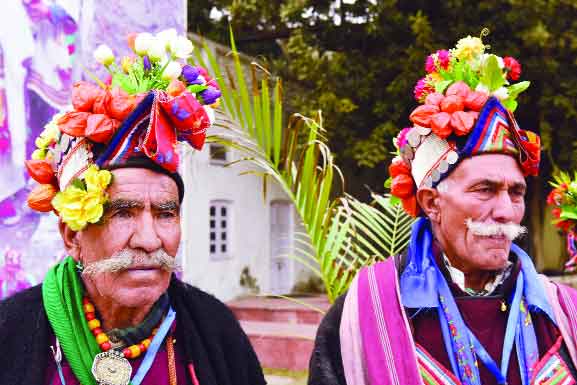Virendra Bangroo’s series of photographs, representing the culture and lifestyle of the Dard Aryans of Ladakh, combines history and calls for saving a dwindling tribe, says U Nair
Not much is known about the Dard Aryans, one of the ancient peoples who are known to still live by age-old cultural practices and beliefs despite facing many odds. They are considered to be ever-vigilant soldiers defending our frontiers along with our Army. It is their spirit of deep valour and courage that needs to be saluted by common mortals like us.
Their life is captured in photographs by Virendra Bangroo at the India International Centre (IIC). The images combine history and the call for attention to a dwindling tribe that needs sustenance.
Rich cultural legacy
The Aryan Valley of Ladakh boasts a colourful and rich legacy of the Dard Aryans inhabiting the area. According to Bangroo, the Dardic languages are a sub-group of the Indo-Aryan languages natively spoken in northern Pakistan’s Gilgit Baltistan and Khyber Pakhtunkhwa, Jammu and Kashmir and eastern Afghanistan. They speak a distinct dialect of Dard-Shina, which is also known among the people of Ladakh as Brokskat. Interestingly, they have a dialect but no script.
Hillside people
Bangroo, an assistant professor at the Indira Gandhi National Centre for the Arts (IGNCA), says “The word Dard itself comes from Daradas, which roughly translates into people who live on the hillsides.” Bangroo, who has spent years studying this community, states that the people of this ethnic community are also linguistically and culturally different from those living in other parts of Ladakh. His images have a poignancy that we cannot miss.
The photographer gives us cluster of images that speak of the ethnicity and rich symbolism in clothes, jewellery and distinctive and colourful head gears. “A Brokpa tribal is identified by a colourful head gear called Tepi that has various colourful props attached, embellished with berry flowers,” says Bangroo. The Tepi, they believe, wards off the evil eye. The women wear heavy metal, gold and silver jewellery along with full-length sheep skin capes and sheep wool pherans. While it might look heavy, it also looks exotic and vintage in terms of design and allure. What entices are the old metal coins which are a compulsory part of the accessories.
Metal to prevent sickness
The men too have their own unique customs in costume, they mostly wear maroon gowns with cummerbunds. There is a belief that metal worn on the body prevents sickness.
With absolutely no medical facilities in the past being far removed from urban settlements, it seems that their head gears are worn for intrinsic meaning — each prop on the head gear has a significant medicinal purpose. The seven-coloured ribbons ward off any ailments caused by the sun or sudden kinds of sickness that are related to the eclipses. The silver brooches ward off planetary influences and the peacock feathers ward off paralyses.
Buddhist leanings
Many of them converted to Buddhism nearly two centuries ago, the Dards as a group are followers of the Drigung Kagyu lineage of Mahayana Buddhism. Bangroo’s research also states that some members of the community, particularly those on the other side of the Line of Control (LOC), are primarily Shia Muslims. What is deeply stirring is their belief in living in harmony with nature. Also, the fact that they still follow age-old, traditional customs of worshipping rivers, trees and mountains and also practice a form of animism, a tradition which, according to some, hails from as far as 5,000 years ago.
Bangroo belongs to the group of scholars at the IGNCA, which has has had an immensely vital contribution in the mapping of intangible cultural heritage of our country. Bangroo, has in his research, traversed the length and breadth of the Himalayas and worked for the preservation of ethnic cultural pockets which has seen leaps and bounds in connectivity.
His work for this community in creating awareness about the rich cultural diversity of the region becomes a boon and a lifeline of sorts. Through his works, we see two community museums in the Aryan Valley, which have become role model institutions for safeguarding the cultural heritage and sustainable development in the region.
(The show runs till 13 May.)


























